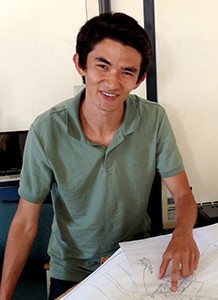 Daniel Gregg is a 2011 graduate of Parker School, and will be a senior this fall at Brown University, where he is studying to be an environmental engineer. He is primarily interested in renewable energy production, especially solar, and integrated “green” building. When he is not studying, Daniel enjoys running, kicking a soccer ball around, singing, playing and listening to music, acting, reading, soaking up some sun, and, when he is home, swashbuckling around the Big Island. He is glad for the opportunity to work at NELHA, where he can both be at home and work on a project with real-life applications.
Daniel Gregg is a 2011 graduate of Parker School, and will be a senior this fall at Brown University, where he is studying to be an environmental engineer. He is primarily interested in renewable energy production, especially solar, and integrated “green” building. When he is not studying, Daniel enjoys running, kicking a soccer ball around, singing, playing and listening to music, acting, reading, soaking up some sun, and, when he is home, swashbuckling around the Big Island. He is glad for the opportunity to work at NELHA, where he can both be at home and work on a project with real-life applications.
Project Title: Mapping out the Miles: Seawater Distribution System Topography
Project Site: Natural Energy Laboratory of Hawai‘i Authority (NELHA)
Mentor: Alex Leonard & Laurence Sombardier Advisor: Keith Olson Collaborator: Michelle Chu
Project Abstract: The Natural Energy Lab of Hawaii Authority (NELHA) provides a large variety of services to its clients, one of the most important of which is acting as a surface-seawater and deep-seawater utility. Over the course of the past 35 years, NELHA has installed one of the largest seawater distribution systems in the world, so that today it serves 41 clients and pumps 30 million gallons per day. Since the first days of installation, however, certain elements of the system have been poorly catalogued, and many of the modifications since have experienced the same lack of documentation. In order to better understand the distribution system, the topology of the system has been mapped by means of GPS survey equipment from Trimble Construction, historic documentation, and professional narrative from the people who had seen the system grow. For project products, AutoCAD mapping software was used to integrate the survey data with past documentation and site maps of NELHA’s facilities, as well as those of its clients, to create a map of the distribution system and site in which it exists. A tabulated and descriptive list of all pipeline features was also created for additional analysis and as a tool for future system upkeep and modification. Together, the two items should enable more efficient and less costly use of the system, and allow for better-documented system changes.